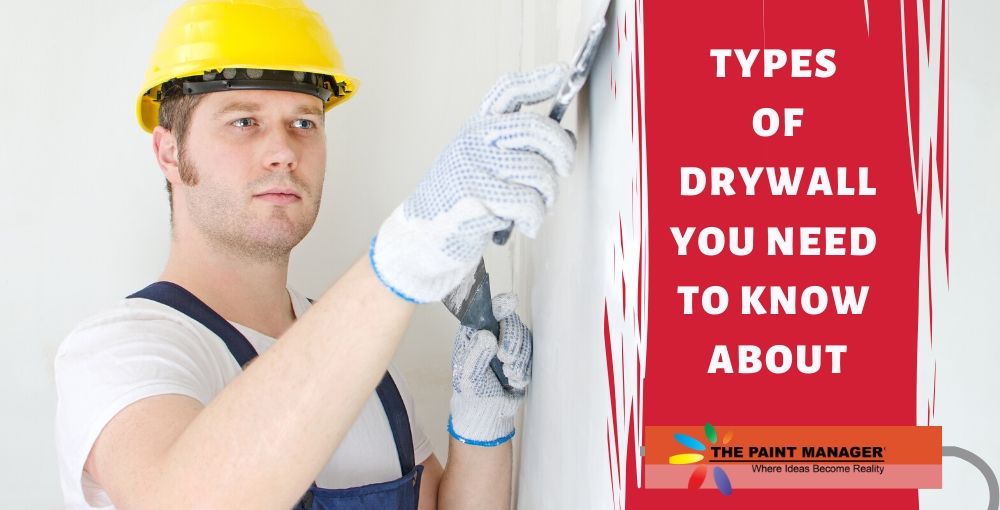Everyone has heard of drywall – which constitutes the interior walls of most post-World War II homes and commercial buildings. But when it comes time for a major home remodeling project involving adding or replacing walls, the wide variety of drywall products can be overwhelming. Even if you’re planning to hire a contractor, a basic knowledge about drywall can help you have a more informed conversation with your contractor, prevent misunderstandings and ultimately get the best results. If you’re planning to go the DIY route, all the more reason to know about what you’re getting into!
First, drywall is known by many names, which can lead to confusion. Sheetrock is often used interchangeably with drywall, as is gypsum and gypsum board. However, as defined by Diffen, “Sheetrock is a brand of drywall that is a registered trademark of the U.S. Gypsum Company. With the exception of a couple of chemicals that allow the Sheetrock formula to be patented, there is practically no difference between Sheetrock and other drywall. Either can be used as construction material for walls and ceilings.”
Now that we’ve cleared that up, here are the major types of drywall.
Regular
As the name implies, regular drywall is the most common. Gypsum – a common mineral found in various places around the world – is at the core, placed between two sheets of paper. Regular drywall is gray on the front, and there is a paper layering at the back, which is generally brown. As regular drywall is available in various sizes, you can use it throughout your house. The most common regular drywall size is a 4-foot by 8-foot sheet.
Moisture-resistant Drywall
Moisture-resistant drywall – also known as greenboard due to its color – is used in bathrooms, kitchens, laundry and utility rooms. If you’ve ever lived up North, you probably know it’s also used for basements. It has the same gypsum core used in standard drywall, but comes with a thicker coating of paper that’s protected by wax for water resistance. Although moisture-resistant, greenboard is not waterproof – so don’t use it if it will be in contact with water. If a bathroom wall pipe leaks (or bursts), or the greenboard is exposed to water under any other circumstance, it will need to be replaced.
Fire-resistant Drywall
According to The Balance Small Business, fire-resistant drywall is available in several thicknesses, which can be used in layers to achieve a higher fire rating. It is harder to cut and work with than regular drywall and normally is used in garages, rooms and apartment buildings, as it is required by several building codes.
Type X drywall is made with special noncombustible fibers. It typically comes in 5/8-inches thickness and this extra thickness can also improve soundproofing.
To receive the “Type X” designation, a gypsum board must achieve at least a one-hour fire resistance rating for 5/8-inch board or a 3/4-hour rating for 1/2-inch board in a single layer, nailed on each face of load-bearing wood framing members.
Sound-resistant Drywall
Sound-resistant drywall is laminated, consisting of a mix of gypsum, wood fibers and polymers. Some brands use a fill of viscoelastic and ceramics. The combination increases the overall STC (sound transmission class). The thickness of the soundproof drywall is the same as that of regular drywall, but this drywall is layered. It is the layering that helps absorb the sound more effectively. Cutting soundproof drywall is a bit harder because it is denser than other types. Soundproof drywall is used in places where noise is a problem or when you want to cut down sound in a room. It is typically used in family rooms, music rooms or where an exterior wall faces a noisy street.
Other types and brands of drywall
Plaster baseboard – also known as blue board drywall – is used for veneer plastering, and has special absorption qualities. Blue board offers higher resistance to water and mold, and fewer steps are involved in veneer plastering. It is mostly used in high-moisture rooms – like bathrooms – and provides the additional benefit of sound-reduction.
PURPLE® is the brand name for a high-performance drywall that resists moisture, mold and mildew. In addition, most PURPLE® drywall products also stand up to scratches, scuffs and dents, and is sound-resistant – making it a good choice for playrooms, garages and utility rooms.
Let us install it
This is where we relate our usual disclaimer. Installing drywall can be a DIY project, but only for those who have the experience and physical ability. If you’ve ever watched that TV show featuring hapless novice house flippers, you’ve seen people who have taken on more than they can competently complete. In addition to risking injury, you also risk incurring serious additional expense if it’s installed improperly. Newbies also risk miscalculating the amount of drywall needed, which results in buying too little or too much.
For those who are confident in their skill, the good folks at PURPLE provide a guide to installation. Their website also offers videos on installation and finishing. But again, as we also always advise, don’t assume you’re an expert because you’ve watched a few video tutorials. Should you decide to go for it, be sure you have all necessary equipment and materials before beginning work – as well as the right safety gear. Follow manufacturer’s instructions.
The Paint Manager is proud to be a trusted repair, remodeling and maintenance resource for Central Florida homeowners and business owners. Our services can take the stress and guesswork out of choosing the right professional for a wide variety of tasks. Contact us to learn more, or schedule an appointment.

